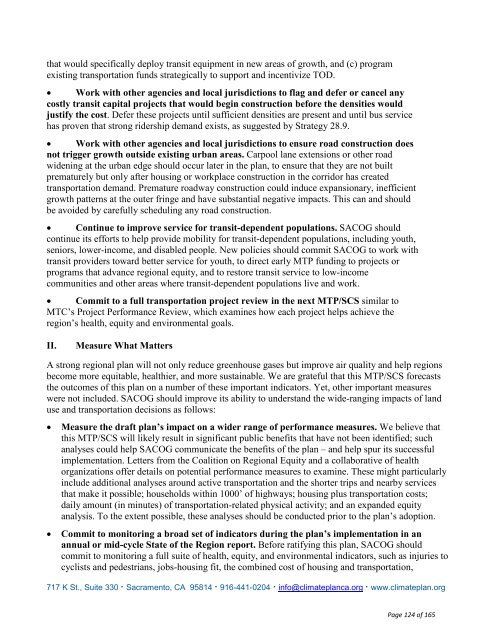Draft MTP/SCS Comments Received - sacog
Draft MTP/SCS Comments Received - sacog
Draft MTP/SCS Comments Received - sacog
You also want an ePaper? Increase the reach of your titles
YUMPU automatically turns print PDFs into web optimized ePapers that Google loves.
that would specifically deploy transit equipment in new areas of growth, and (c) program<br />
existing transportation funds strategically to support and incentivize TOD.<br />
• Work with other agencies and local jurisdictions to flag and defer or cancel any<br />
costly transit capital projects that would begin construction before the densities would<br />
justify the cost. Defer these projects until sufficient densities are present and until bus service<br />
has proven that strong ridership demand exists, as suggested by Strategy 28.9.<br />
• Work with other agencies and local jurisdictions to ensure road construction does<br />
not trigger growth outside existing urban areas. Carpool lane extensions or other road<br />
widening at the urban edge should occur later in the plan, to ensure that they are not built<br />
prematurely but only after housing or workplace construction in the corridor has created<br />
transportation demand. Premature roadway construction could induce expansionary, inefficient<br />
growth patterns at the outer fringe and have substantial negative impacts. This can and should<br />
be avoided by carefully scheduling any road construction.<br />
• Continue to improve service for transit-dependent populations. SACOG should<br />
continue its efforts to help provide mobility for transit-dependent populations, including youth,<br />
seniors, lower-income, and disabled people. New policies should commit SACOG to work with<br />
transit providers toward better service for youth, to direct early <strong>MTP</strong> funding to projects or<br />
programs that advance regional equity, and to restore transit service to low-income<br />
communities and other areas where transit-dependent populations live and work.<br />
• Commit to a full transportation project review in the next <strong>MTP</strong>/<strong>SCS</strong> similar to<br />
MTC’s Project Performance Review, which examines how each project helps achieve the<br />
region’s health, equity and environmental goals.<br />
II.<br />
Measure What Matters<br />
A strong regional plan will not only reduce greenhouse gases but improve air quality and help regions<br />
become more equitable, healthier, and more sustainable. We are grateful that this <strong>MTP</strong>/<strong>SCS</strong> forecasts<br />
the outcomes of this plan on a number of these important indicators. Yet, other important measures<br />
were not included. SACOG should improve its ability to understand the wide-ranging impacts of land<br />
use and transportation decisions as follows:<br />
• Measure the draft plan’s impact on a wider range of performance measures. We believe that<br />
this <strong>MTP</strong>/<strong>SCS</strong> will likely result in significant public benefits that have not been identified; such<br />
analyses could help SACOG communicate the benefits of the plan – and help spur its successful<br />
implementation. Letters from the Coalition on Regional Equity and a collaborative of health<br />
organizations offer details on potential performance measures to examine. These might particularly<br />
include additional analyses around active transportation and the shorter trips and nearby services<br />
that make it possible; households within 1000’ of highways; housing plus transportation costs;<br />
daily amount (in minutes) of transportation-related physical activity; and an expanded equity<br />
analysis. To the extent possible, these analyses should be conducted prior to the plan’s adoption.<br />
• Commit to monitoring a broad set of indicators during the plan’s implementation in an<br />
annual or mid-cycle State of the Region report. Before ratifying this plan, SACOG should<br />
commit to monitoring a full suite of health, equity, and environmental indicators, such as injuries to<br />
cyclists and pedestrians, jobs-housing fit, the combined cost of housing and transportation,<br />
717 K St., Suite 330 · Sacramento, CA 95814 · 916-441-0204 · info@climateplanca.org · www.climateplan.org<br />
Page 124 of 165
















